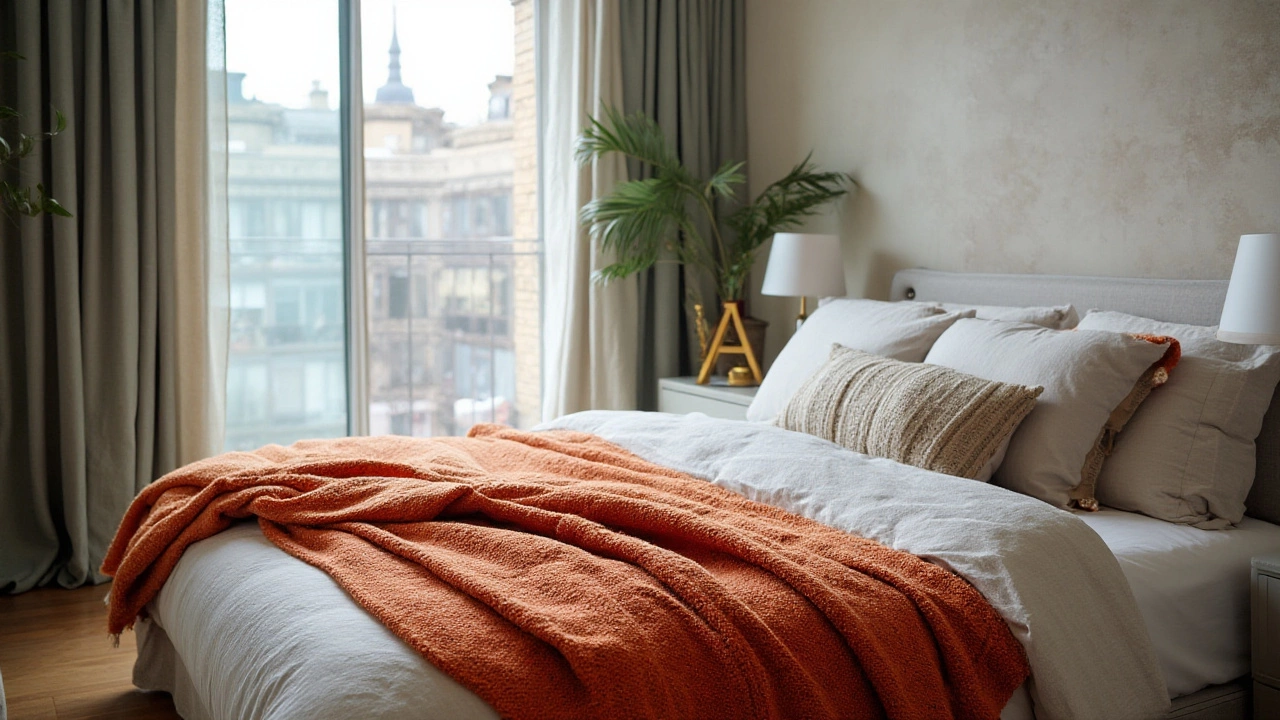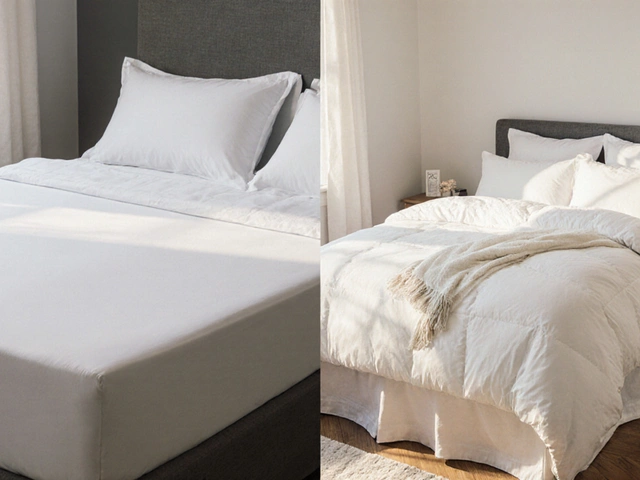Bedding is so much more than just a setting for sweet dreams. It's an ensemble of comfort and style, meticulously crafted to ensure you rest well and wake refreshed. Dive into the world of bedding, where every element—from the texture of the cotton sheets to the fluffiness of the duvet—plays a role in crafting your perfect sleep sanctuary.
Understanding bedding could change your sleep quality. It includes the practical everyday essentials like pillowcases, sheets, and blankets, but also the sophisticated adornments like comforters and throws. Each piece has its purpose and plays a part in how restful your night becomes.
Join me on a journey through thread counts and fabric types as we explore the heart of what makes bedding a pivotal element of home life and personal wellness.
- The Basics of Bedding
- Types of Bedding Materials
- Importance of Bedding in Sleep Quality
- Choosing the Right Bedding for Your Needs
- Caring for Your Bedding
- Trendy Bedding Styles and Innovations
The Basics of Bedding
When we think about bedding, our minds often drift first to those sheets freshly washed under the sun. However, bedding encompasses a rich tapestry of textiles and accessories harmoniously coming together to create a sleep haven. At its core, bedding includes a variety of pieces, each serving a distinct function—each as important as the other. Common components include the bed sheet, a fitted or flat creation designed to cover the mattress, and the pillowcases, which cocoon our heads in softness. The insulating layer often takes shape as a comforter or duvet, meant to wrap around you like a warm hug in the coolness of night. Equally vital is the mattress protector, an unsung hero safeguarding against allergens and prolonging the mattress's life.
The variety of materials used in bedding is staggering, offering a bounty of textures and comfort levels. Cotton, prized for its breathability and durability, remains a perennial favorite, while options like linen and bamboo offer eco-friendly alternatives with a touch of elegance. One must consider thread count when selecting these fabrics, which affects texture and longevity—the higher the thread count, generally, the softer the fabric. A simple approach to selecting the right material is understanding the climate and one's sleep habits, leading to a more personalized and comfortable experience. As per a recent survey, 67% of individuals reported an enhanced sleep cycle after switching to bedding tailored to their needs, revealing the impact of choosing correctly.
Philippa Kaye, an expert in home textiles, once said,
"Bedding is fundamentally about crafting a personal statement—a space that reflects who you are while providing refuge from the day's chaos."When you delve into the world of bedding, you find it's a realm where functionality meets artistry. Intricate patterns and vibrant colors can transform a simple room into a sanctuary, with styles ranging from bohemian swirls to minimalist geometrics. Opting for reversible bedding can add zest—a quick flip changes the whole vibe of a room. Understanding each component of bedding is essential for making choices that affect both health and design, ensuring comfort and aesthetic goals intertwine seamlessly. Dive deep into this world where a thousand threads come together to cradle you to sleep.
Types of Bedding Materials
When choosing bedding, the material is one of the most crucial factors. Selecting the right fabric can mean the difference between a good night's sleep and a night spent tossing and turning. Cotton, for instance, remains a staple choice for many due to its softness, breathability, and durability. This natural material is especially beneficial for individuals with sensitive skin, as it's hypoallergenic and gentle. On the flip side, there's linen, which is celebrated not only for its natural breathability but also for its moisture-wicking properties. Perfect for warmer climates, linen's textured feel only gets softer with every wash, making it a long-term favorite for any bedding collection.
Then there's the often-underrated silk. While it might seem a luxurious indulgence, silk bedding offers unparalleled benefits, including natural temperature regulation and its skin-friendly components, which reduce friction and prevent hair breakage. For those interested in eco-friendly options, there's the rise of organic cotton and bamboo bedding. Both materials promote environmental sustainability and come with their own sets of benefits—organic cotton being the pesticide-free alternative and bamboo offering antimicrobial properties.
Blended Fabrics and Innovation
In recent years, the bedding industry has witnessed innovation with blended materials. Polyester-cotton blends, often referred to as polycotton, combine the softness of cotton with the wrinkle-free, durable nature of polyester, offering a budget-friendly option. Meanwhile, microfiber bedding, made from finely woven fibers, presents a plush feel often likened to cotton but with added warmth. An interesting trend is the rise of performance fabrics in bedding, which borrow technology from athletic wear to wick moisture away and regulate body temperature. Such innovation ensures sleepers stay comfortable year-round.
"The fabric of our lives impacts not only our days but our nights. Choosing the right material can drastically enhance your sleep experience," writes textile expert Hannah Yates in Sleep & Materials Magazine.
Finding the perfect bedding material boils down to personal preference and specific sleeping needs. It's vital to consider seasonal changes, your individual comfort levels, and even the aesthetic appeal each material brings to your bedroom. Armed with this knowledge, you can curate a bedding ensemble that not only complements your sleep but enhances your everyday living environment.

Importance of Bedding in Sleep Quality
When considering the elements that contribute to restful sleep, bedding often emerges as a surprisingly pivotal factor. It shapes the environment in which you drift into slumber, influencing not only comfort but also hygiene and even psychological well-being. Various components of bedding work together to regulate temperature, provide support, and offer tactile comfort. The significance of appropriate bedding has been underscored by numerous sleep studies, which reveal that choosing the right materials can drastically reduce sleep disturbances and enhance the restorative properties of sleep.
Material choice is a critical aspect of bedding that affects sleep quality. Natural fibers like cotton, known for their breathability, allow air to circulate, thereby preventing overheating – a common disruptor of sleep. In contrast, synthetic materials might trap heat, making sleep a sweaty ordeal. A study by the National Sleep Foundation highlighted that temperature control is essential, with many individuals suffering from poor sleep due to overheating. Thus, investing in high-quality, breathable bedding is not just a matter of luxury but essential health advice.
The tactile feel of your bedding can have subtle yet profound effects on your sleep quality. Sheets with higher thread counts are usually softer and more luxurious, making the bed more inviting. However, it’s important not to be swayed solely by numbers; the material itself often has a more significant impact. Deciding between percale and sateen, for instance, isn’t just about texture but about what aligns best with your personal sleep needs. Cotton is crisp and cool, whereas sateen offers a lustrous finish that feels gentle against sensitive skin.
The Sleep Council emphasizes that "getting the right combination of mattress, linen, and personal preference is vital for a quality night’s rest." This holistic approach is echoed in sleep advice globally, reminding us that attention to detail in bedding translates directly into improved sleep patterns.
Interestingly, the psychological impact of bedding is not to be dismissed either. The aesthetics and tidiness of your bedclothes can profoundly affect your mood and stress levels. A neatly made bed can invoke a sense of calm and order, crucial for mental clarity and relaxation. Color themes and designs are more than just decorative choices; they reflect personal styles and can even influence emotional well-being. This is why so many interior designers champion monochrome or soothing earth tones for bedroom settings.
To sum up, bedding plays a multifaceted role in sleep quality. It manages thermal comfort, supports physical relaxation through tactile pleasure, and helps foster a peaceful mental environment. Thus, thoughtfully selecting and maintaining your home decor through bedding is integral to nurturing both your physical and mental health.
Choosing the Right Bedding for Your Needs
When it comes to selecting bedding that resonates with your personal needs, the task can seem both exhilarating and daunting. There are so many options out there, and each component plays its own important role. The first consideration usually involves the material. Do you prefer the cool crispness of cotton, the luxurious feel of silk, or the cozy warmth that flannel provides in the colder months? The choice heavily depends on your personal comfort as well as seasonal needs. High-quality bed linen can greatly enhance your sleep experience by allowing your skin to breathe and adjusting to your body's temperature.
Make sure to consider the thread count when selecting your bedding, as it often indicates quality. An ideal range is usually between 200 to 800, with anything higher offering a softer, more durable fabric. However, it's essential to remember that a higher thread count doesn’t always equal better quality, as the type of cotton and weave also play crucial roles. Egyptian cotton sheets are renowned for their softness and strength, and many sleep experts suggest them as a standard in comfort. A survey by the Sleep Foundation indicated that 75% of people believe quality bedding has improved their sleep substantially.
Assessing Your Sleep Needs
Identifying your unique sleep habits and preferences can guide you in choosing the most suitable bedding. If you tend to get hot at night, breathable materials like cotton or linen are your best options, as they allow air circulation. On the other hand, if you feel cold, especially during winter nights, investing in a good quality down comforter or a thick wool blanket can make all the difference. It’s also worth examining any allergies or skin sensitivities when choosing bedding, opting for hypoallergenic or organic fabrics can provide comfort without irritation."The right bedding choice can not only enhance the aesthetic of a bedroom but transform the quality of one’s rest," says interior designer Emily Anderson, renowned for her bedroom makeovers that combine style with comfort.
Design and Aesthetic Considerations
Beyond functionality, the aesthetics of your bedding should not be underestimated. The colors and patterns you choose can deeply affect the atmosphere of your rest space. Light pastels and neutral tones tend to create a serene environment conducive to restful sleep, while bold patterns and vibrant colors may inject energy and personality into your room. An interesting fact from the Journal of Sleep and Sleep Disorders Research shows that 60% of individuals sleep better in a tidy, visually pleasing environment, underscoring the importance of well-chosen bed linens.Whether you are redecorating or simply replacing old bedding, invest a little time to explore and understand what best matches your lifestyle and comfort preferences. After all, the perfect bedding set not only supports a good night's sleep but also complements your living space's style, creating a peaceful retreat that feels just right for you.

Caring for Your Bedding
In the quest for optimal comfort and hygiene, knowing how to care for your bedding is as important as selecting it. Bedding has a profound impact on your sleep quality and overall health, so investing effort into its maintenance is worthwhile. Regular washing is key to keeping your bedding fresh and clean. Wash sheets and pillowcases weekly, as they are in direct contact with your skin. This prevents the accumulation of sweat, oils, and dead skin cells, which could encourage dust mites and bacteria. For more substantial items like comforters and duvets, aim for a thorough clean every few months, unless specified otherwise by care instructions.
Temperature controls in washing are crucial too. Most bed linen can be laundered at home, but always check the label for the recommended setting. Typically, hot water is excellent for battling germs, but it can also lead to fading and shrinking over time. A warm water setting often strikes the perfect balance between cleanliness and fabric longevity. For a natural approach, hang your bedding in the sun to dry; sunlight is a natural disinfectant that can help brighten whites without added bleach.
Don't forget to pay attention to storage, which plays a significant role in the longevity of your bedding. Make sure they are completely dry before storing to prevent mold and mildew. Use a cool, dry place and avoid plastic storage containers; instead, opt for breathable cotton bags that help protect fabrics while allowing airflow. Add a little lavender sachet or cedar blocks to keep linens fresh and moth-free. A gentle reminder: folding linens neatly and with care not only makes them last longer but also makes it easier to find what you need when transforming your bedroom into an oasis of comfort.
Rotate your bedding set periodically to reduce wear and tear on favorite items. This simple practice helps extend the lifespan of your prettier and pricier pieces. According to the Sleep Foundation, “Investing in two or three sets of sheets helps bolster the longevity of all your linens by allowing each set a chance to rest.” Diverse patterns and textures can transform the aesthetic appeal of your bedroom as they are swapped out seasonally. This is especially a point to consider when involved in home decor.”
Indeed, overlooked pillow maintenance can quickly lead to discomfort and sleep issues. Fluff pillows daily to help them maintain their shape and support. Many pillows can be machine washed and dried—check labels for the ideal method. Keeping a pillow protector as an extra barrier under the pillowcase is also wise to shield against allergens.
Sleep comfort is something deeply tied to the freshness and quality of your bedding. Regularly dealing with minor repairs is part of caring for it—mend any unraveling threads or small tears promptly to avoid greater damage. If you notice any stains, tend to them swiftly using appropriate techniques depending on the stain's nature. Understanding fabric types is crucial for stain removal, as certain solutions might damage delicate materials like silk or bamboo.
Ultimately, the goal is to create a sanctuary where you can unwind, fully relaxed, knowing your bedding is in peak condition. Caring for these intimate accessories translates to better sleep and more rejuvenating nights. So take the time, invest in quality bedclothes, and relish the peaceful, healthy slumber you've earned through diligent upkeep.
Trendy Bedding Styles and Innovations
The world of bedding is constantly evolving, with innovations that marry functionality with style. Today, bedding trends are leaning towards eco-friendly materials and customized designs, reflecting a growing awareness of sustainability paired with a desire for personalized comfort. Organic cotton and bamboo sheets have become popular choices, known for their softness, breathability, and low environmental impact. These materials offer a unique tactile experience that enhances the sleep environment while reducing the carbon footprint.
As homes became a sanctuary during the pandemic, people began to invest in luxurious and comforting bedding that offered a sense of coziness and retreat. The return to maximalist patterns reintroduced bold colors and geometric designs, making bedrooms a canvas of expression. Textured linens and layered bedding, which invite the sleeper to snuggle into personalized cocoons, are particularly trendy. With them, pastels and neutral tones have dominated the scene, favorable for the peace and serenity they induce.
Innovations in bedding technology have also paved the way for enhanced sleep experiences. Temperature-regulating sheets, integrating Phase Change Materials (PCM), dynamically adjust to the body's heat, ensuring a consistent night’s sleep without the bother of night sweats. Another groundbreaking development is the rise of anti-microbial bedding using silver threads—designed to keep bacteria and allergens at bay.
"The future of bedding lies in our ability to blend comfort with conscious living," notes Jessica Brandt, a sleep specialist renowned for her innovative research in sleep technology.
Not to be overlooked is the rise of smart bedding designed to connect with smartphone apps, which allows users to monitor sleep patterns and adjust their sleep comfort settings accordingly. As technology and lifestyle converge, bedding is being reimagined to cater to tech-savvy individuals seeking efficiency and insights into their personal health.
Biodegradable and sustainable packaging for bedding products is becoming the norm as brands focus on environmental responsibility. Developers focus on creating bedding that not only supports our sleeping habits but also our ecological footprints. In keeping with this effort, companies emphasize ethical manufacturing practices and sourcing transparent materials, which resonate with informed consumers.
The art of choosing bland bed linen is indeed evolving into a science. With these innovations, our bedrooms can be transformed into personalized sanctuaries that support our well-being, both physically and mentally.







